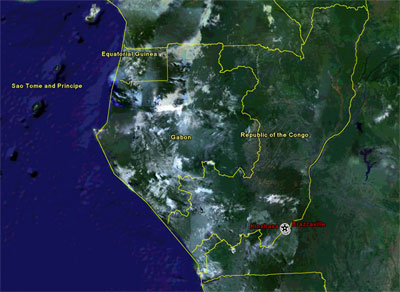CONGO
Please note, this page is not longer being updated. For more recent information, please see news.mongabay.com and use the search function to find the country feed. For more up-to-date data on forest cover and loss, check out Global Forest Watch.
| Congo Forest Figures
Forest Cover Total forest area: 22,471,000 ha % of land area: 65.8% Primary forest cover: 7,464,000 ha % of land area: 21.9% % total forest area: 33.2% Deforestation Rates, 2000-2005 Annual change in forest cover: -17,000 ha Annual deforestation rate: -0.1% Change in defor. rate since '90s: 0.8% Total forest loss since 1990: -255,000 ha Total forest loss since 1990:-1.1% Primary or "Old-growth" forests Annual loss of primary forests: -5600 ha Annual deforestation rate: -0.1% Change in deforestation rate since '90s: 0.7% Primary forest loss since 1990: -28,000 ha Primary forest loss since 1990:-1.1% Forest Classification Public: 100% Private: 0% Other: 0% Use Production: 88.2% Protection: n/a Conservation: 4.4% Social services: n/a Multiple purpose: 7.4% None or unknown: n/a Forest Area Breakdown Total area: 22,471,000 ha Primary: 7,464,000 ha Modified natural: 14,957,000 ha Semi-natural: n/a Production plantation: 51,000 ha Production plantation: n/a Plantations Plantations, 2005: 51,000 ha % of total forest cover: 0.2% Annual change rate (00-05): n/a Carbon storage Above-ground biomass: 8,356 M t Below-ground biomass: 2,005 M t Area annually affected by Fire: 17,000 ha Insects: n/a Diseases: n/a Number of tree species in IUCN red list Number of native tree species: 334 Critically endangered: n/a Endangered: n/a Vulnerable: n/a Wood removal 2005 Industrial roundwood: 1,450,000 m3 o.b. Wood fuel: 1,317,000 m3 o.b. Value of forest products, 2005 Industrial roundwood: $222,545,000 Wood fuel: $20,091,000 Non-wood forest products (NWFPs): n/a Total Value: $242,636,000 More forest statistics for Congo |
Congo's forests are highly threatened by logging, colonization of forest lands, and poaching of animal species. Industrial logging has accelerated since the government privatized the timber industry, and much of the new exploitation is taking place in the relatively untouched forests of northern Congo, not in the easily accessible southern region where timber harvesting has historically taken place.
The Republic of Congo was once one of Africa's largest petroleum producers, but with declining production it may increasingly look towards its forests as a source of revenue.
While the government of Congo likes to claim that it has a sustainable forest policy and has introduced legislation to limit what species can be extracted from its forests, reports from the ground indicate that logging companies may largely ignore these regulations and log intensely. Further, illegal logging is a well-documented problem, and corruption undermines even the most basic enforcement efforts.
The hunting of wild game is a major conservation concern in Congo. Bushmeat hunting proliferates in logging camps and along logging roads, while elephants are poached for their ivory. Poor rural colonists use logging roads to access hunting grounds and establish homesteads, where they collect fuelwood and use slash-and-burn techniques to clear rainforest for subsistence agriculture.
Nouabal�-Ndoki is one of Congo's best known and most important national parks. Located deep in the Congo Basin rainforest, this part is home to gorillas, chimps, forest elephants, buffalos, and bongos. It, together with Lob�k� National Park in Cameroon and Dzanga-Ndoki National Park in the Central African Republic, forms a giant protected area consisting of primary lowland rainforest. In total, almost 16 percent of Congo's land area is under some form of protection.
Recent articles
Suggested reading - Books
Unless otherwise specified, this article was written by Rhett A. Butler [Bibliographic citation for this page]
Other resources
Contact me if you have suggestions on other rainforest-related environmental sites and resources for this country.

Image copyright Google Earth, MDA EarthSet, DigitalGlobe 2005
CIA-World Factbook Profile
FAO-Forestry Profile
World Resources Institute
Last updated: 4 Feb 2006
